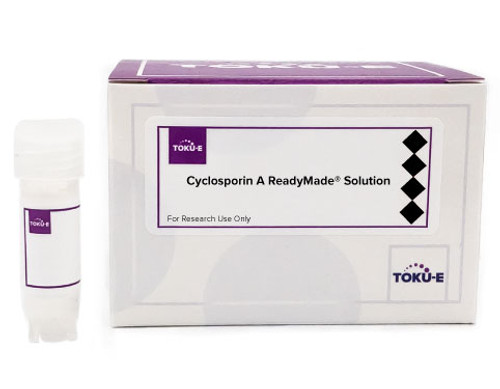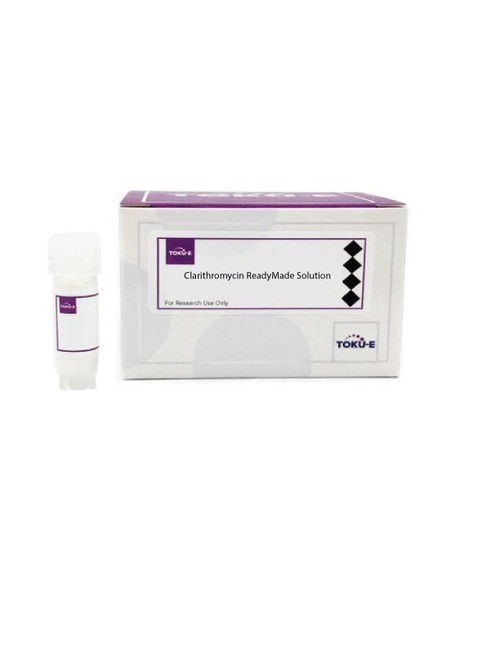Mycophenolic Acid ReadyMade™ Solution is provided as a sterile-filtered solution formulated in β-cyclodextrin solution at a concentration of 12.5 mg/ml for enhanced solubility.
Mycophenolic Acid is a natural active metabolite of Mycophenolate mofetil. Mycophenolic Acid was discovered by Bartolomeo Gosio in 1893. It can inhibit DNA synthesis of T and B lymphocytes via selective inhibition of inosine monophosphate dehydrogenase. It also acts as an immunosuppressive agent commonly used in solid-organ transplantation. As a selection agent, it is used for transfected animal cells expressing the E. coli gene for xanthine-guanine phosphoribosyl transferase. SBECD is an excipient for enhanced solubility and stabilty.
Mycophenolic Acid is considered a dangerous good. Quantities above 1 g may be subject to additional shipping fees. Please contact us for questions.
We also offer:
- Mycophenolic Acid (M012)
| Mechanism of Action | Mycophenolic Acid blocks inosine monophosphate dehydrogenase in the guanosine monophosphate pathway and suppresses cytokine-induced nitric oxide production. |
| Spectrum | Anisomycin is active against Gram-negative bacteria and protozoa. It has in vitro activity against dengue and Zika flaviviruses in cell culture. |
| Eukaryotic Cell Culture Applications | Mycophenolic Acid exhibited multifarious effects on endothelial cells including inhibition of ICAM-1 expression, neutrophil attachment, IL-6 secretion, and the process of angiogenesis, which might contribute to the efficacy in vasculitis (Huang et al, 2005). |
| Cancer Applications | Mycophenolic Acid acts as an inhibitor for inosine monophosphate dehydrogenase (IMPDH), an enzyme responsible for controlling the rate of guanine monophosphate synthesis. IMPDH is required for T-cell and B-cell growth and proliferation to a higher degree than other host cells. |
| Plant Biology Applications | Sugar cane smut disease is caused by the basiomycete Sporisorium scitamineum. The fungus undergoes a morphological transition from budding growth of haploid cells to filamentous growth of the dikaryon to enable it to forage for nutrients and evade the host plant immune system. The target of tihis dimorphic switch is ammonium transporter gene Ssa2. Mycophenolic Acid (100 ug/ml) repressed the expression of Ssa2 and therefore could be used in treatment of this plant disease (Zhong et al, 2019). |
| Molecular Formula | C17H20O6 |
| References |
Benjanuwattra J, Chaiyawat P, Pruksakorn D, Koonrungsesomboon N (2020) Therapeutic potential and molecular mechanisms of Mycophenolic Acid as an anticancer agent. Eur J Pharmacol. PMID 32949604 de Jonge H, Naesens M, Kuypers DR (2009) New insights into the pharmacokinetics and pharmacodynamics of the calcineurin inhibitors and Mycophenolic Acid: Possible consequences for therapeutic drug monitoring in solid organ transplantation. Ther Drug Monit. 31(4):416-35. PMID 19536049 Panattoni A, Anna FD, Triolo E (2007) Antiviral activity of tiazofurin and Mycophenolic Acid against Grapevine Leafroll-associated Virus 3 in Vitis vinifera explants. Antiviral Res. 73 (3):206-211 PMID 17125850 Sweeney MJ, Hoffman DH and Esterman MA (1972) Metabolism and biochemistry of Mycophenolic Acid. Cancer Res. 32(9):1803-1809 Yanfei Huang, Zhihong Liu, Haidong Huang, Hao Liu, Leishi Li (2005) Effects of Mycophenolic Acid on endothelial cells. Int. Immunopharmacol. 5(6):1029-1039 PMID 30543296 |








